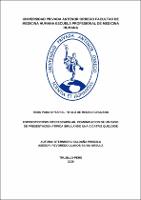| dc.contributor.advisor | Revoredo Llanos, Silvia Ursula | |
| dc.contributor.author | Sternberg Saldaña, Priscila | |
| dc.creator | Sternberg Saldaña, Priscila | |
| dc.date.accessioned | 2020-10-20T03:27:16Z | |
| dc.date.available | 2020-10-20T03:27:16Z | |
| dc.date.issued | 2020 | |
| dc.identifier.uri | https://hdl.handle.net/20.500.12759/6664 | |
| dc.description.abstract | La esporotricosis es una micosis subcutánea causada por el Sporothrix schenkii. De
presentación clínica variada, la que nos ocupa posee forma cutánea fija de evolución
polimorfa, lo que ocasiona un diagnóstico tardío y tratamientos incorrectos que
conllevan a complicaciones.
Se presenta el caso de una paciente pediátrico, sin antecedentes de inoculación
traumática. Con historia de lesión de inicio nodular tipo picadura en región
interescapular. Dos meses después se ulcera en la región central y se cubre de costras.
El paciente se automedica con betametasona, clotrimazol y gentamicina crema,
generando remisión temporal de la lesión. Posteriormente, la lesión reaparece y es
diagnosticada como cicatriz queloide, infiltrándose con corticoides. Un mes y medio
después, se agrava además con dolor y prurito, y es tratada con antibióticos. Sin
presentar mejoría, acude a consulta dermatológica donde, por cultivo, es diagnosticada
con esporotricosis cutánea fija granulomatosa complicada con sobreinfección por
Candida spp. y Staphylococcus aureus.
Se realiza tratamiento con Itraconazol y Yoduro de potasio presentando mejoría clínica.
El diagnóstico temprano de la esportricosis cutánea es esencial para evitar cambios
atípicos en la evolución de la lesión. El tratamiento adecuado en el momento oportuno,
minimiza las secuelas físicas y psicológicas en el paciente. | es_PE |
| dc.description.abstract | Sporotrichosis is a subcutaneous mycosis caused by Sporothrix schenkii complex. Its
clinical presentation is diverse, but the fixed cutaneous form has a polymorphic evolution,
causing a diagnosis delay and wrong treatments that lead to complications.
We present the case of a pediatric patient, with no history of traumatic inoculation. Came
with a history of a sting-like nodular lesion in the interscapular region. Two months later it
ulcerates in the central region and is covered with scabs. The patient self-medicates with a
cream that contains betamethasone, clotrimazole and gentamicin, generating temporary
remission of the lesion. Subsequently, the lesion reappears and is diagnosed as a keloid
scar, treated with infiltration of corticosteroids. A month and a half later, it is also
aggravated with pain and itching, and is treated with antibiotics. Without showing any
improvement, she went to a dermatological clinic where, by culture, she was diagnosed
with fixed granulomatous cutaneous sporotrichosis complicated with Candida spp
overinfection. and Staphylococcus aureus.
Treatment with Itraconazole and Potassium Iodide is performed presenting clinical
improvement.
The early diagnosis of cutaneous spotrichosis is essential to avoid atypical changes in the
evolution of the lesion. The right treatment at the right time minimizes the physical and
psychological sequelae in the patient. | en_US |
| dc.description.uri | Tesis | es_PE |
| dc.format | application/pdf | es_PE |
| dc.language.iso | spa | es_PE |
| dc.publisher | Universidad Privada Antenor Orrego | es_PE |
| dc.relation.ispartofseries | T_MED_2849 | |
| dc.rights | info:eu-repo/semantics/openAccess | es_PE |
| dc.source | Universidad Privada Antenor Orrego | es_PE |
| dc.source | Repositorio institucional - UPAO | es_PE |
| dc.subject | Micosis | es_PE |
| dc.subject | Esporotricosis | es_PE |
| dc.title | Esporotricosis interescapular. Comunicación de un caso de presentación atípica simulando una cicatriz queloide | es_PE |
| dc.type | info:eu-repo/semantics/bachelorThesis | es_PE |
| thesis.degree.level | Título Profesional | es_PE |
| thesis.degree.grantor | Universidad Privada Antenor Orrego. Facultad de Medicina Humana | es_PE |
| thesis.degree.name | Médico Cirujano | es_PE |
| thesis.degree.discipline | Medicina | es_PE |

